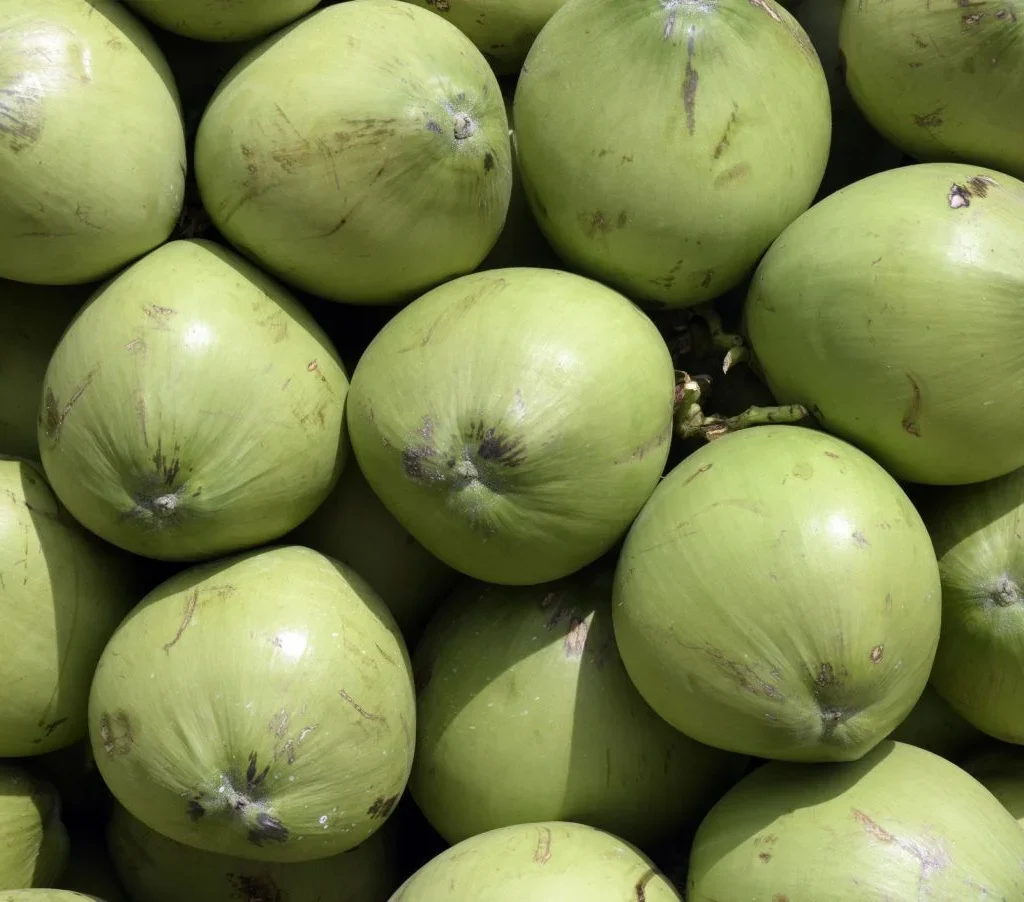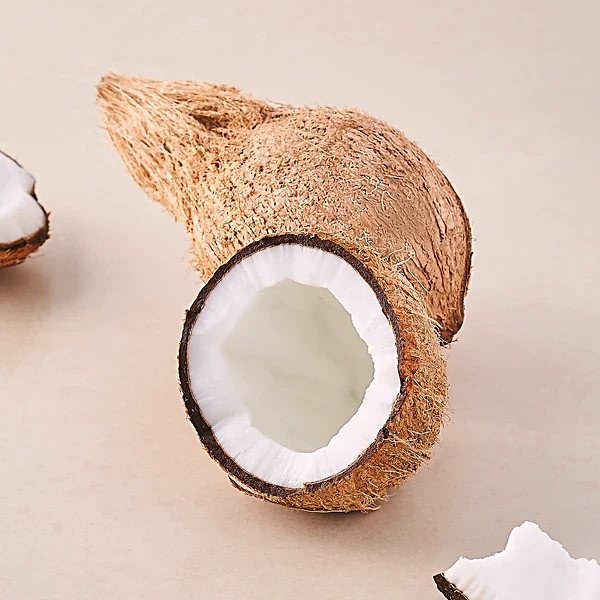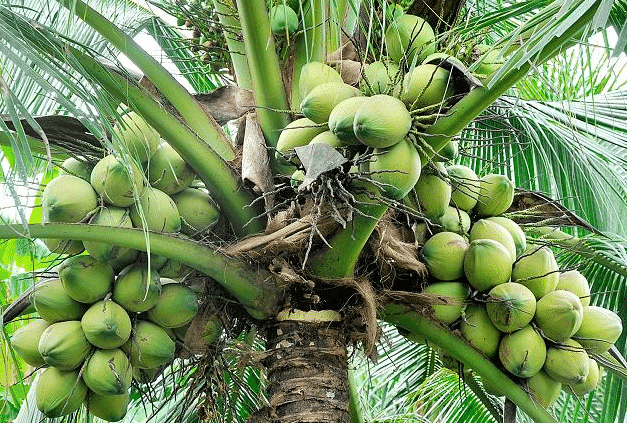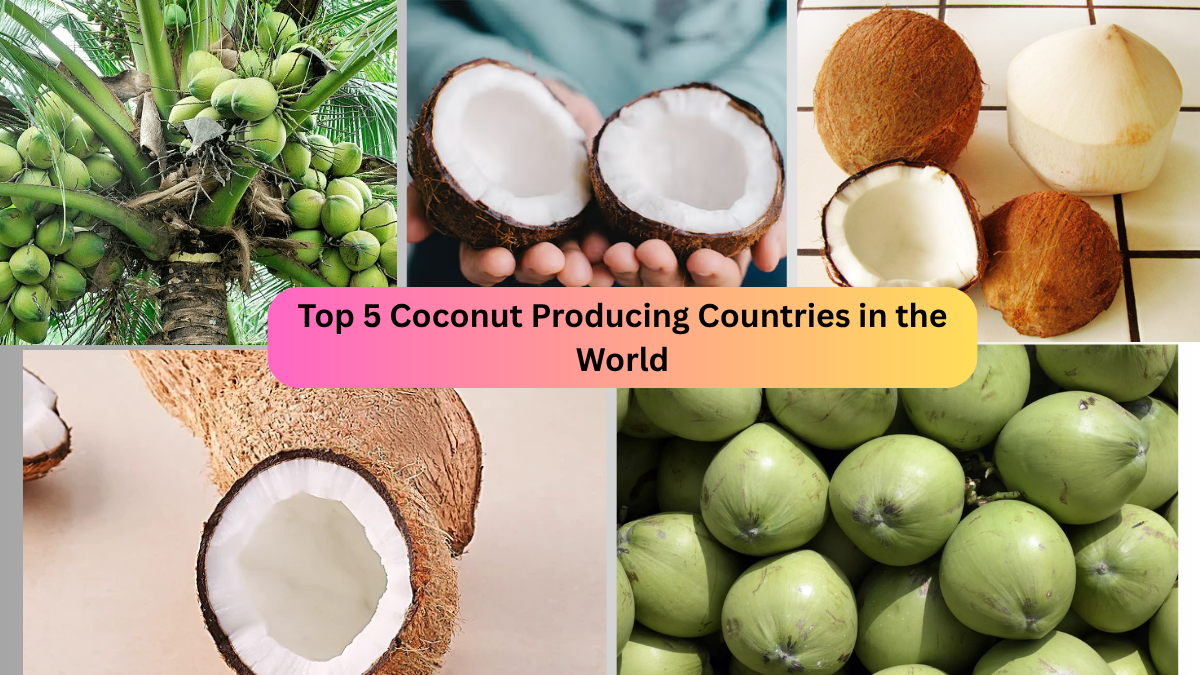Coconuts are among the world’s most treasured tropical crops, celebrated for their culinary, medicinal, and industrial uses. From hydrating coconut water and creamy milk to nourishing oils and natural fibers, virtually every part of the coconut tree is utilized — earning it the nickname “the tree of life.”
With the growing global demand for natural, organic, and plant-based products, coconut farming has become an important agricultural industry in many tropical countries. But which nations lead the world in coconut production?
In this article, we’ll dive deep into the top 5 coconut producing countries in the world, highlighting their annual output, the regions where coconuts are grown, and their contributions to global markets.
1. Indonesia — The World’s Leading Coconut Producer

Key Facts:
- Annual Production: Over 17 million metric tons
- Global Market Share: Around 27%
- Major Products: Fresh coconuts, copra, coconut oil, desiccated coconut, coconut water
Indonesia holds the crown as the largest coconut producing country on Earth. The nation’s equatorial climate, abundant rainfall, and rich volcanic soil make it a natural paradise for coconut palms.
Top Growing Regions:
- North Sulawesi
- Riau
- East Java
- Lampung
- West Java
Coconuts have been a part of Indonesia’s cultural heritage for thousands of years. Today, millions of smallholder farmers rely on coconut cultivation for their livelihood. Indonesia exports vast quantities of coconut oil, copra (dried coconut meat), coconut water, and activated coconut charcoal to markets around the world, particularly the United States, China, the Middle East, and the European Union.
Indonesia’s coconuts are also the foundation of many traditional Indonesian dishes like nasi uduk, soto betawi, and rendang.
2. Philippines — A Coconut Export Powerhouse

Key Facts:
- Annual Production: Around 14.7 million metric tons
- Global Market Share: Approx 23%
- Major Products: Copra, virgin coconut oil, coconut water, desiccated coconut
The Philippines has long been one of the world’s most important coconut producers and exporters. Coconuts cover nearly 3.5 million hectares of farmland, particularly in provinces like Quezon, Davao Region, and Zamboanga Peninsula.
The Philippines is especially known for its copra production — dried coconut meat used for oil extraction — and is one of the top suppliers of virgin coconut oil globally. Its coconuts also serve as vital ingredients in Filipino cuisine, such as ginataang gulay, laing, and buko pie.
Coconuts play a pivotal role in the Philippine economy, providing jobs to over 3.5 million farmers. The government continues to invest in organic farming initiatives, replanting programs, and fair-trade certifications to maintain its market position.
3. India — A Domestic Giant and Cultural Symbol
Key Facts:
- Annual Production: Approximately 14.1 million metric tons
- Global Market Share: Around 21%
- Major Products: Coconut oil, desiccated coconut, coir products, coconut shell charcoal
India is another coconut-producing heavyweight, with coconuts deeply embedded in its culture, religion, and cuisine. While India consumes the vast majority of its coconut harvest domestically, it is still one of the top global producers.
Top Growing States:
- Kerala (nicknamed “God’s Own Country” and India’s coconut capital)
- Tamil Nadu
- Karnataka
- Andhra Pradesh
Coconuts are used in countless Indian dishes like coconut chutney, payasam, and avial, and are an essential offering in religious rituals and festivals.
In addition to food, India is a world leader in coir fiber products (made from coconut husks) and coconut-based cosmetics. The Kerala Coconut Development Board actively promotes sustainable and organic coconut farming to enhance both domestic use and export potential.
4. Sri Lanka — The Island of Coconuts

Key Facts:
- Annual Production: Around 2.5 million metric tons
- Global Market Share: Approx 4%
- Major Products: Coconut oil, coconut milk powder, desiccated coconut, activated carbon
Often referred to as “The Pearl of the Indian Ocean,” Sri Lanka has built a global reputation for its premium-quality coconut products. Despite its small size compared to the other coconut giants, Sri Lanka’s coconuts are highly valued for their rich oil content and quality.
Top Growing Areas:
- Kurunegala
- Puttalam
- Gampaha
- Colombo
Coconuts are an essential ingredient in Sri Lankan cuisine, where dishes like pol sambol, coconut roti, and kiribath showcase their versatility. Additionally, the country is a top exporter of organic coconut products, including coconut water, virgin coconut oil, and coconut milk powder.
Sri Lanka is also a pioneer in sustainable coconut farming, with a strong emphasis on organic and fair-trade certifications.
5 Brazil — South America’s Coconut Leader

Key Facts:
- Annual Production: Over 2.3 million metric tons
- Global Market Share: Approx 3.5%
- Major Products: Fresh coconuts, coconut water, coconut oil
While Asia dominates coconut production, Brazil holds its own as South America’s top producer. Coconuts thrive in Brazil’s tropical northeast, particularly in the states of Bahia, Ceará, and Pernambuco.
Brazil is best known for its booming fresh coconut water market — both domestically and abroad. The country exports large quantities of packaged coconut water to the United States, Europe, and other Latin American countries.
In Brazil, coconuts are used in popular dishes like cocada (a coconut-based dessert) and moqueca (a coconut milk seafood stew).
Quick Recap: Top 5 Coconut Producers (2024)
| Rank | Country | Annual Production (Metric Tons) |
|---|---|---|
| 1 | Indonesia | 17+ million |
| 2 | Philippines | 14.7 million |
| 3 | India | 14.1 million |
| 4 | Sri Lanka | 2.5 million |
| 5 | Brazil | 2.3 million |
(Source: FAO & World Coconut Market Report 2024)
Why Coconuts Matter Globally

The coconut industry doesn’t just supply delicious and healthful products — it also:
- Provides livelihoods for over 10 million farmers worldwide
- Powers billion-dollar export markets in coconut oil, copra, desiccated coconut, and coir
- Supports sustainable farming, organic agriculture, and fair-trade initiatives
- Plays a significant role in tropical biodiversity and environmental conservation
Coconuts are now in higher demand than ever, with booming markets for coconut water, virgin coconut oil, plant-based milk alternatives, and organic skincare products.
Fun Facts About the World’s Coconut Industry
- The Husk of a coconut can be turned into eco-friendly ropes, brushes, mats, and car seat padding.
- Coconut water is naturally sterile and has even been used in emergencies as a substitute for IV fluid.
- The Husk and shell are increasingly being used to make activated carbon for air and water filters.
- Indonesia’s North Sulawesi province is often called the “coconut belt” because of its dense coconut plantations.
Conclusion
The world’s coconut production is concentrated in a handful of tropical countries, with Indonesia, the Philippines, and India leading the pack. These nations not only meet domestic demand but also supply global markets with high-quality coconut products, fueling industries ranging from food and cosmetics to renewable energy and construction.
As demand for natural, organic, and plant-based products rises, the influence of these coconut-producing countries will continue to grow — making them key players in both agriculture and sustainable development for decades to come.



